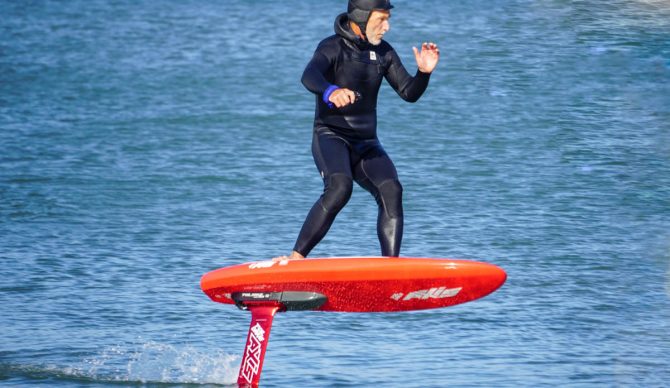
Ripping it up on the Foil Drive Assist MAX with the AXIS Foil Drive board and integrated mast setup. Photo: Will Sileo//The Inertia
If you’re tuned into the world of foil sports, no doubt you’ll have seen footage of people ripping around on prone, downwind, wing, and even pump-foil setups with that cute little Foil Drive motor pod on their mast. Just as in cycling, e-assist has become a reality in foiling, opening up new spots and offering a way into foiling for riders who wouldn’t otherwise give it a go.
Launched in 2021 and now in its second generation of product development, Foil Drive offers a rider-proven e-assist system that’s creating a ton of well-deserved stoke amongst foil riders around the world. As an expert kite- and wing-foiler, I was psyched to see for myself how Foil Drive would integrate into my own riding—and to use it to learn to prone, downwind, and pump foil.
| Pros | Cons |
| Electric boost for foiling! | Requires maintenance |
| Portable, modular, and to an extent, upgradeable design | Adds weight |
| Enthusiastic rider community | Less athletic |
| Creates new possibilities for foil riders | Hard to move between masts |
First Impressions/Testing
I did most of my testing with a Foil Drive Assist MAX with the largest Power battery, a 25cm/10” cable, and the universal mast adaptor. This highest-priced version of the kit totals $5,323, while the least-expensive setup, the Foil Drive Assist Slim with the Performance battery, totals $4,495. The Foil Drive kit arrived in a killer neoprene case that holds all the parts including the charger and battery. Everything you need to fit the system to your foil rig is in there, including tools. The only thing missing is a roll of electrical tape.
The Assist Max/Slim is Foil Drive’s second generation “Gen2” product. What’s changed from the Gen1 Foil Drive (referred to as the Foil Drive Assist Plus and priced at a budget-friendlier $2,977) is the battery and controller are now integrated into a pod that mounts between the mast and the bottom of your board, instead of in a little plastic “lunch box” on top of the board. Another big difference is that most of the Gen2 batteries are 40 volts instead of 28 volts, providing more thrust. The guts of the motor itself are the same, but if you want to upgrade without some major DIY, you’ll have to swap out the entire system.
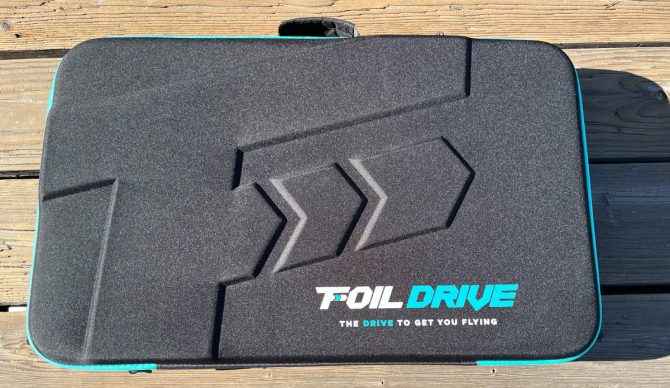
The entire setup comes nicely packaged in a neoprene case with everything you need to get riding. Photo: Bowen Dwelle//The Inertia
Of course, I wanted to get out riding as soon as possible, so I whipped out the battery and got it charging while I dove into installing the Foil Drive unit itself. Installation is fairly straightforward, but there are a number of parts and specific steps, so it helps to follow along with the installation guide. One thing that you’re sure to notice is that you have to wrap the mast and motor cable with electrical tape, resulting in a bit of a home-brew look for the final assembly. This is how it’s supposed to look, and it works just fine—but it’s also part of the reason that many Foil Drive riders end up investing in an integrated mast.
See FD Assist Max on Mackite See FD Assist Slim on Mackite See FD Assist Plus (Gen1) on Mackite
Notable Features
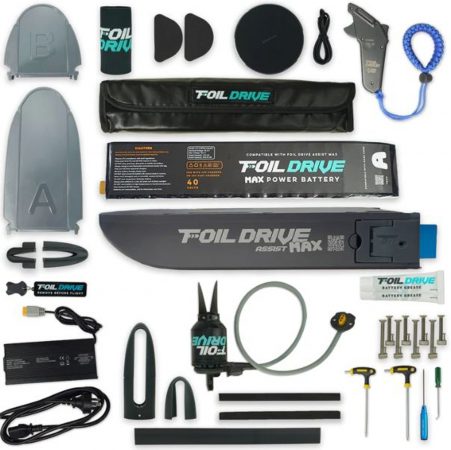
Available In: Assist MAX, Assist Slim
Size Tested: Assist MAX w/ Power and Sport batteries
Weight: 5.8kg / 12.8lb (Assist MAX with Power battery)
You’ll need to choose between the MAX (thicker) and Slim (thinner) units, both of which themselves have two different battery sizes—making for a total of four battery sizes ranging from 6lb for the MAX Power down to just 2.3lb for the Slim Performance battery. The MAX and Slim systems and their respective housings are not interchangeable. In other words, you can’t use a Slim battery with a MAX unit, and vice versa.
Based on my testing, I recommend the MAX setup for most riders – and Foil Drive is certainly selling way more MAX units. The difference in base weight between the Slim and MAX units is only 1lb, and most people are going to want the extra power. Advanced and expert prone foilers should take a closer look at the Slim, which does have the highest thrust-to-weight ratio.

Assist MAX vs Assist Slim stat comparison. Photo: Foil Drive
You’ll also need to choose a motor cable length. Unless you’re going to use your Foil Drive as an e-foil or you’re already a competent prone or downwind foil rider, I recommend 25cm/10” to begin with.
With everything installed on the 60-liter AXIS Foil Drive Board and the Axis Spitfire 1100 wing, the total weight was 33 pounds, which could be reduced to 26-29 pounds by going down to a smaller board, foil, and battery. For me, the added weight was noticeable but didn’t affect my riding as much as I expected.
One of the first things I noticed is that training with Foil Drive improved my feel for the height at which I’m flying the foil, allowing me to spend more time higher on the mast. Even as an expert foiler, practicing pumping with Foil Drive helped me learn to ride more efficiently, more consistently.
What can a Foil Drive do for your foiling? That all depends on what kind of riding you’re doing, so we’ve broken it down for you by discipline: Prone/Surf, Downwind, Pumping, Winging, and eFoil.
Prone / Surf
For someone like me who’s just too lazy to paddle, Foil Drive seems like the ideal way to get into foiling in waves. I’m happy to report that from my very first Foil Drive wave session, I was able to get out and catch a few! My testing convinced me that prone surfing is probably the discipline where Foil Drive offers the most benefit with the least tradeoff, because Foil Drive makes it possible to catch rolling, non-breaking waves that just aren’t rideable in any other way. As a beginner, I got about just over 30 minutes on a Max Power battery and a little less on the Max Sport.
With all the other foil disciplines, there’s an argument to be made that using Foil Drive might prevent you from learning some of the skills required, but not for prone surfing in otherwise unrideable conditions. If you have a lot of this kind of wave action where you live, Foil Drive is gonna change your life, for sure. For some helpful tips on getting started in the surf, check out the Foil Drive Masterclass video on prone surfing, above.
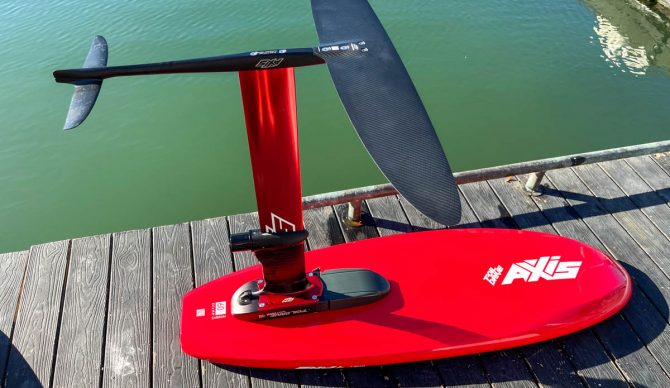
With the Foil Drive motor mounted at 25cm, you’ll have easy access to power, but will be able to get the motor pod out of the water when pumping or on a wave for maximum efficiency. Photo: Bowen Dwelle//The Inertia
Downwind
As someone coming to the Foil Drive from more of a sailing-than-surfing background, and who hasn’t been attracted by paddle-up downwind foiling, I was psyched to see from my testing that Foil Drive is an excellent tool for learning to downwind and learning to connect bumps on foil. I was able to motor upwind and do downwind laps with the same 60-liter board that I used in the surf, also demonstrating how Foil Drive makes downwinding possible on a smaller board that would be impossible to paddle up for anyone, even the most expert paddlers. Having not previously felt the magic of connecting bumps on a big foil with nothing in my hands, Foil Drive has opened the door for me to the potential of downwind foiling.
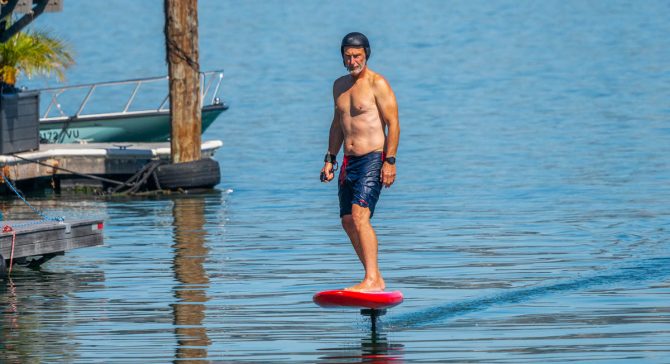
There is really no better tool to learn pump-foiling than a Foil Drive. Photo: Bowen Dwelle//The Inertia
Pumping
After seeing all those Insta clips of guys pumping for hours nonstop on lakes in Switzerland and Canada, I was super stoked to use Foil Drive to learn to pump, especially since it’s clear that good pumping is one of the unlocks for downwind and prone foiling. My testing showed that Foil Drive makes it possible to learn to pump foil without having to dock start—just motor out, ollie up, and go—and repeat 100x, all without having to swim back to a dock.
Even without a mega pump foil, I was able to connect pumping sequences on the Spitfire 1100 enough to see how awesome flat water pumping can be. Of course the Foil Drive adds some weight, but you just get so many more attempts in because of being able to get back up straight away with the motor that within a few sessions I was pumping for more than a minute at a time.
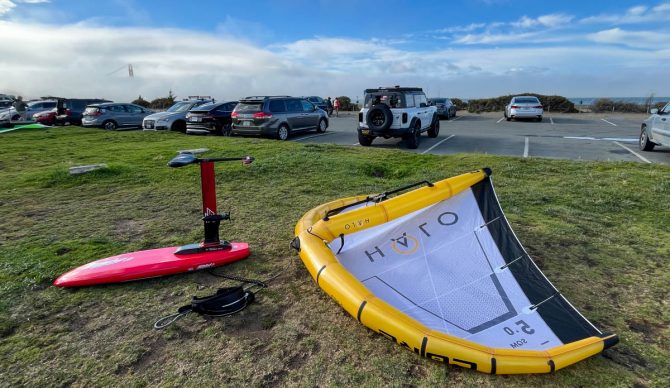
Getting out there to test the Foil Drive as an assist for winging. It works, but can get fairly complicated. Photo: Bowen Dwelle//The Inertia
Winging
I’ve seen that some people are using the Foil Drive to learn to wing or to get out to the windline in places where it isn’t close to shore. I was a bit dubious, but I wanted to see how it would go for myself. I went out with the same 60-liter AXIS board, Spitfire 900, and my 5m wing on a light-wind day, and I have to say: Foil Drive works while winging, but I wouldn’t really recommend it.
Having the board, wing, and the Foil Drive to deal with all at once makes things pretty freaking complicated. If you’re learning to wing, my take is that you’d be better served just focusing on that—and if you’re an experienced winger and you’re thinking of going out where there’s only wind some distance offshore, that might not be the greatest choice in the first place, and also probably not the best idea to depend on a motor to get you out there and back. Overall, I’d rather just choose a spot where I can rely on the wind. For those that do want to FD-wing, the forthcoming mini remote should make it much easier to get power when you want it.
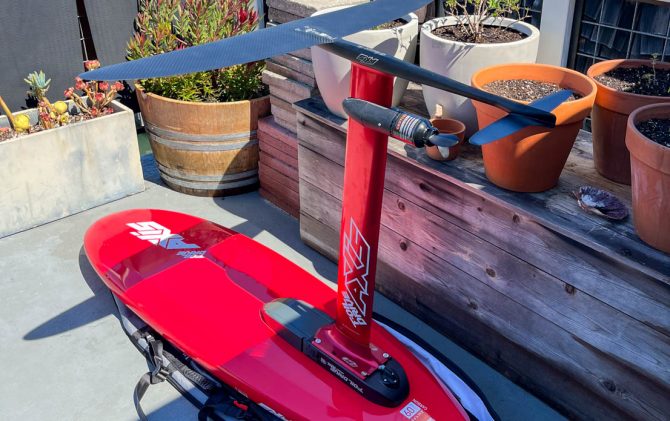
With the foil drive motor installed at 70cm “eFoil” height, you won’t be getting the motor pod out of the water for efficient pumping or swell-riding, but you will be able to rip a high-powered turn. Photo: Bowen Dwelle//The Inertia
E-Foil
I also tested the Foil Drive using an AXIS integrated mast with the motor pod at e-foil height. I’ve ridden a bunch of e-foils, and especially with a modern, glide-efficient foil, Foil Drive makes a pretty awesome e-foil, at least for occasional use.
Of course your run time isn’t going to be anything like what you can get from a full-on e-foil with a gargantuan battery. Also, since swapping your Foil Drive between masts is more than a bit of a pain, most people who use their Foil Drive in e-foil mode are going to end up with two masts, one for e-foiling and another for other types of riding. If you’re considering Foil Drive versus e-foils, be sure to check out our E-Foil Buyers Guide.

A folding prop can help reduce drag for better glide when the motor is disengaged. Photo: Will Sileo//The Inertia
Gear Compatibility and Integration
One of the key design features of the Foil Drive system is a high degree of modularity and compatibility. Foil Drive is designed so that it can be used with just about any foil board setup you might have, and for any foil discipline—prone, downwind, winging, pump, you name it. On top of that, the Foil Drive system is itself highly modular, so you can swap batteries, propellers, cables, and even use Assist MAX and Slim units with the same motor and mast setup. The entire system is designed so that you are free to customize your Foil Drive rig exactly how you want.
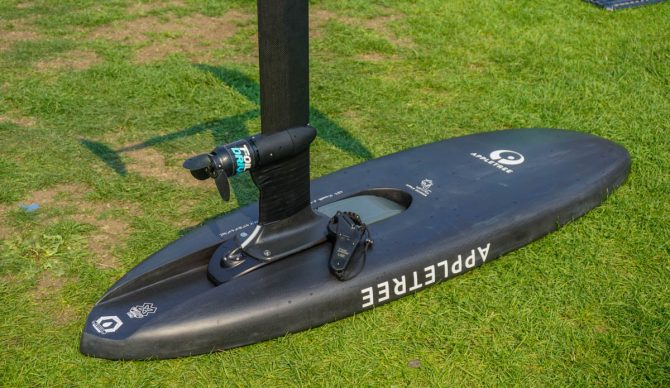
Dugout Foil Drive boards are beginning to hit the market. Photo: Will Sileo//The Inertia
Boards
As with the rest of it, you can use whatever board you want with your Foil Drive, but there are already FD-specific boards emerging, especially in the prone/downwind segment. Many boards designed for Foil Drive tend to have features like a longer and narrower shape much like many of the latest “mid-length” wing boards, a bottom profile optimized for takeoff under power, and longer mast tracks.
Something to be aware of in selecting a board is that some full-carbon foil boards can block the signal from the hand controller to the main unit. Ideally, choose a board with some fiberglass construction that will allow the signal to pass without any interference — or even act as an antenna itself, as some FD-specific boards do now.
Recently, there has been some discussion and experimentation with cut-out/trenched/channeled boards that allow the Foil Drive main unit to be inset or “embedded” in the bottom of the board, which reduces friction and moves the center of gravity up and closer to your feet. An example of this is the prototype from AppleTree, pictured above. Board makers such as Buzz, 270°, and Alex Aguera have also begun to catch on. That said, if you’re starting out with Foil Drive, my recommendation is to keep it simple, so just use your existing foil board or grab one of the boards on this list from MAC Kite.
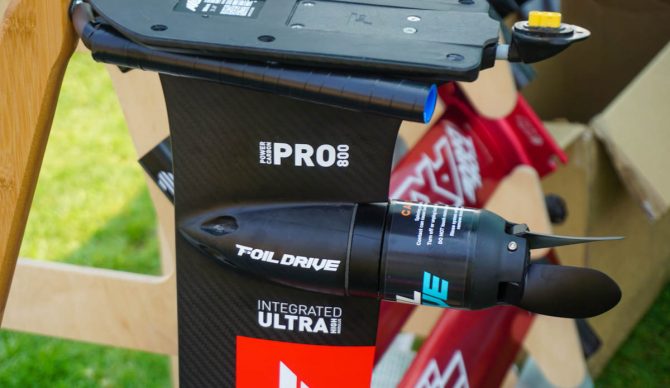
All Foil Drive integrated masts are currently aluminum, but this prototype of a carbon integrated mast was on display at the 2024 AWSI, and will be hitting production soon. Photo: Will Sileo//The Inertia
Masts
Depending on which model you choose, Foil Drive will add 35-50mm (3.5-5cm) to your total mast height, but adding Foil Drive to your foil setup isn’t really going to change the mast length that you’ll want to use for whatever type of foiling you’re doing.
The Gen2 Foil Drive motor cables are currently fixed-length, but removable cables are coming soon. Be aware that the forthcoming swappable cables will not be retrofittable to existing Foil Drive stators with the permanently attached cables. There will be an upgrade kit for existing customers but it will require purchasing a new stator, cable, and puck to use with the existing rotor.
As previously mentioned, because Foil Drive is designed to retrofit to your existing gear, part of installing the Foil Drive motor pod and cable to your mast is taping the cable down to your mast. This does look a little janky and is a bit less than ideal in terms of hydrodynamics, however, there’s no doubt it performs better than it looks. It’s worth noting that, once the tape is in place, it’s not very practical to swap your Foil Drive motor from one mast to another or to move it up or down the mast on a regular basis, as you’ll need to do a fresh tape-job every time. For this reason, many Foil Drive owners have a dedicated Foil Drive mast, and this may even be reason enough to consider a Foil Drive integrated mast further down the road.
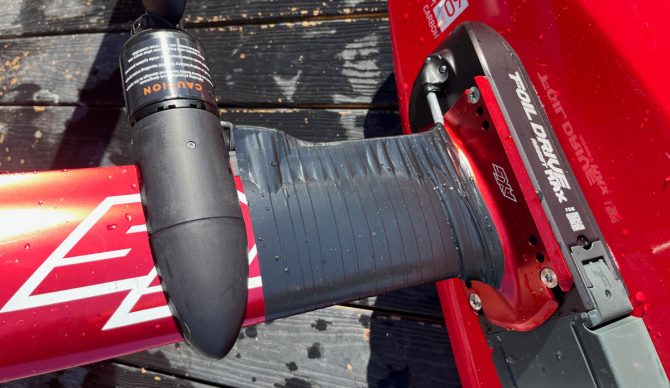
Unless you go the integrated mast route, you’ll want to wrap your cable/mast with electrical tape for better hydrodynamic efficiency. Photo: Bowen Dwelle//The Inertia
Drawbacks
I love the simplicity of foiling, and there’s no getting around the fact that Foil Drive makes things more complicated. One real gotcha that didn’t occur to me until I had tested the system is that it’s not very practical to move your Foil Drive on a regular basis once installed on a mast, thanks to the taping/installation process. To an extent, that cancels out some of the value proposition of being able to use your existing foil gear. From my own testing, it’s clear that most riders are going to end up with at least one mast dedicated to Foil Drive pretty quickly in their journey. Fair enough, innovation means new gear, and integrated masts perform better anyhow – just don’t make the mistake of thinking that you’re going to be able to continue to use one single mast with and without Foil Drive.
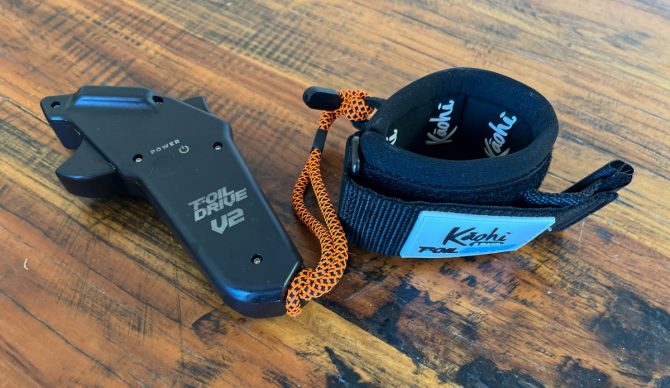
We found that picking up a better remote-leash is a worthy investment. Photo: Bowen Dwelle//The Inertia
One of the most common complaints about things like ebikes – and now Foil Drive – is that they make these sports less challenging, and that it’s sort of cheating to use e-assist. For me, the physical effort of foil sports are a big part of the appeal, and there’s no way you’re going to feel as worked after a Foil Drive session as you would after, let’s say, SUP or prone foil surfing. Draw your own conclusions on that score, but I think it’s also important to point out that while Foil Drive does make things easier, it’s also drawing people into foil sports that wouldn’t otherwise be foiling at all, and opening up waves that would be otherwise unrideable. No doubt, pulling the trigger on a remote control isn’t as athletic as paddling, but it’s certainly more athletic than not going foiling at all.
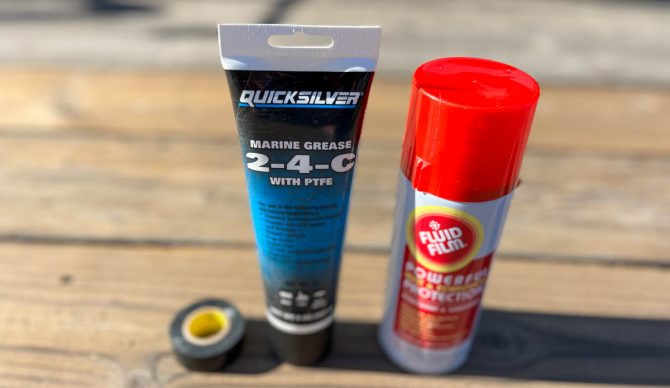
A roll of electrical tape, Marine Grease and Fluid Film are a couple of items you’ll want to get your hands on ASAP to keep your Foil Drive in top-notch condition. Photo: Bowen Dwelle//The Inertia
Especially for folks coming from water sports with no moving parts, the fact that some maintenance is required for your Foil Drive is something else to consider. As a winger, I usually throw my gear straight into my van after riding, and use it for years without any maintenance. In contrast, you’re going to need to at least wash and lubricate your Foil Drive rig after every session, and ideally pay some attention to optimal battery charging. During my testing, at first I was intimidated by the detailed maintenance instructions, but I got used to the process very quickly and realized after a few rides that it’s not really very cumbersome at all.
All these minor drawbacks can be summed up in a phrase: it’s a motor, mate. Given that, Foil Drive might not be for you if you are a total purist, or if you’re not the kind of person who wants to deal with some mechanical fiddling and a bit of maintenance. Before you dive in, ask yourself this question: what kind of relationship do I want with a motor?
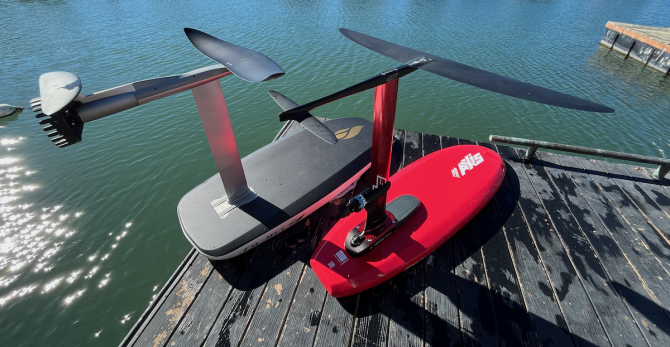
Side-by-side testing of a Sifly Stellar R eFoil and the Foil Drive Assist MAX. Photo: Will Sileo//The Inertia
The Competition
While Foil Drive is currently the clear market leader in foil-assist, there are at least a couple of other similar products out there, including the Manta Takeoff, and Stoke Foil Boost. The Foil Boost has the potential advantage of the battery being integrated into the motor pod, meaning that there’s no separate battery housing or cable connecting the two components, so it should be quicker to mount and unmount from the mast than the Foil Drive.
If you’re certain that you’re going to want to use foil-assist on one foil mast, and then also use that same mast at other times without assist, you might want to have a closer look at Foil Boost — or just get yourself a Foil Drive integrated mast. On the other hand, if you’re considering Foil Drive versus e-foils, be sure to check out our E-Foil Buyers Guide.

Speed, power, and flow with the Axis Foil Drive Board and Spitfire foil. Photo: Will Sileo//The Inertia
Final Thoughts
The Foil Drive kit comes with almost everything you need, but there are a few other things you’re going to want right away: a roll of quality electrical tape, a can of lanolin spray lubricant like Fluid Film, a tube of lithium-based marine grease, an Inline Battery Checker, and a more robust leash for the hand controller (I didn’t find the stock leash very secure). Some recent upgrades that will be available by the time you read this include a v2 motor with a removable cable (so you can change the cable length more easily), airline-approved travel batteries, and controller accessories for prone and wing foiling. Note that if you’re going to want a dedicated Foil Drive mast (and you probably will), you can save some money by getting a kit that includes an integrated mast right from the start.
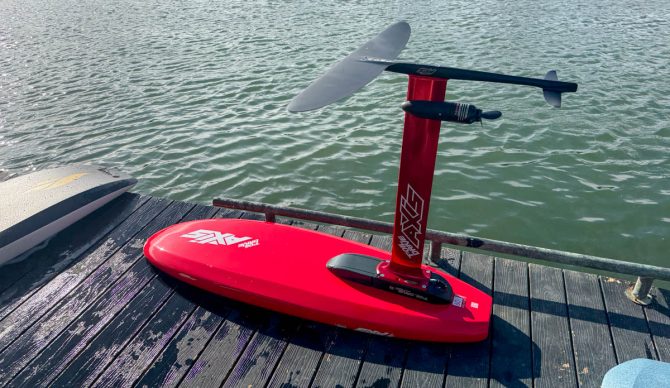
An integrated mast makes for a cleaner and more hydrodynamic setup. Photo: Will Sileo//The Inertia
For riders coming to Foil Drive now, it’s an exciting time, and if you enjoy the foil-assist experience, you’ll be part of the evolution of this emerging discipline. Overall, my testing showed that Foil Drive delivers on its promises, and the way it can be used to unlock new foiling disciplines and situations is totally awesome. As a lifelong water and board sports aficionado, I love having Foil Drive as part of my quiver. If you’re interested in electric assist for your foiling and you’re not deterred by the cost or the complexity of adding Foil Drive to your setup, I think you’ll be stoked with Foil Drive—so go for it!
See FD Assist Max on Mackite See FD Assist Slim on Mackite See FD Assist Plus (Gen1) on Mackite
Editor’s Note: As well as eFoils, we’ve covered wing foiling gear extensively. If you’re thinking about getting started winging, here’s our Beginner Wing Foil Gear Guide, and be sure to check out our article on The Best Wing Foil Packages. For wing foil boards (many of which are compatible with Foil Drive, check out our Best Wing Foil Boards review. For more gear reviews and features on The Inertia, click here.



